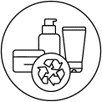Decoding The Labelling - Glossary
Carbon Footprint
The amount of greenhouse gas emissions (CO2) released throughout a product’s life cycle, i.e. during the production of ingredients and packaging, the product manufacturing, its transportation, use by consumers and the recycling of its packaging.
Did you know?
[HAIRCARE]
On average, 70% of the carbon footprint of a shampoo comes from the energy needed to heat the water in your shower.
[SKINCARE]
-You can reduce your carbon footprint by refilling your product several times. That’s why we are developing more and more refillable and reusable products. Our refillable products display the average impact for the use of a product and 4 refills. Our reusable products display the average usage impact of a product refilled once, but you can refill more!
-The metalization of packaging is an energy-consuming process, we are currently working with our suppliers on alternative technologies.
Water Footprint
Quantity of water used throughout the product's life cycle and impact on water quality, particularly during the manufacture of ingredients and packaging, the production of products in the factory, use (showering...) and the discharge of wastewater.
Did you know?
[HAIRCARE] On average, 60% of the water footprint of a shampoo or a conditioner comes from the use phase!
This is why we are working to improve the rinsability of our shampoos and conditioners. You can also choose leave-in conditioners, which are often better for the planet.
Responsible Manufacturing plant

A manufacturing plant that, year after year, reduces its greenhouse gas (CO2) emissions, water consumption, waste generation, and that contributes to the development of local employment - especially for people in vulnerable economic situations - and access to training for its employees.
Did you know?
Since 2005, we have reduced our industrial sites' water consumption by 53% (per finished product), their CO2 emissions by 87% (in tons of CO2 equivalent) and their waste production by -38% (in grams per finished product*).
*excluding sludge, excluding shuttle packaging rotations, including shuttle packaging at sourceCertified Paper/Cardboard FSC™ or PEFC
The paper or cardboard used in the product packaging (leaflets or folding boxes) come from responsibly managed forests or other controlled sources that are respectful of the environment, biodiversity, and people. They are independently certified following the conditions defined by either the Forest Stewardship Council™ (FSC™) or the Program for the Endorsement of Forest Certification (PEFC).
Recyclable Materials

Recyclable
Components that can - where the infrastructure allows - be collected and treated by a special industrial process to give rise to a new material.
The 4 Principles of the United Nations Global Compact on Labor Rights
All direct suppliers of our product components or ingredients have committed to respect the fundamental principles of the UN on labor standards.
- The right of workers to associate freely and engage in collective bargaining
- No forced or compulsory labor
- No child labor
- No discrimination among worker
Did you know?
Since 2020, the L'Oréal Group has carried out more than 4891 on-site social audits conducted by accredited third parties.
Suppliers Committed to Social Inclusion
Ingredient and packaging suppliers that provide access to work and a decent wage to people in socially and/or economically vulnerable communities. These suppliers support at least one Solidarity Project.
Did you know?
93 165 people gained acces to work through the Inclusive Sourcing programme in 2023.





